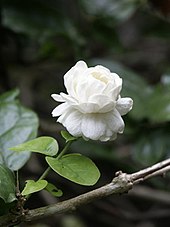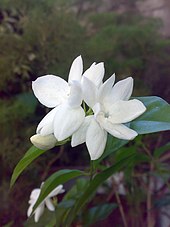The Philippines adopted the Sampaguita (Arabian jasmine, Jasminum sambac) as its national flower because it symbolizes purity and cleanliness due to its colour and sweet odour.
Jasminum sambac is a species of jasmine native to South and Southeast Asia. It is a small shrub or vine growing up to 0.5 to 3 m (1.6 to 9.8 ft) in height. It is widely cultivated for its attractive and sweetly fragrant flowers. The flowers are also used for perfumes and for making tea. It is known as the Arabian jasmine in English. It is the national flower of the Philippines, where it is known as Sampaguita. It is also one of the three national flowers of Indonesia, where it is known as Melati Putih.
Jasminum sambac is classified under the genus Jasminum under the tribe Jasmineae. It belongs to the olive family Oleaceae.
 Despite the English common name of "Arabian jasmine", Jasminum sambac is not originally native to Arabia. The habits of Jasminum sambac support a native habitat of humid tropical climates and not the arid climates of the Middle East. Early Chinese records of the plant points to the origin of Jasminum sambac as South and Southeast Asia. Jasminum sambac (and nine other species of the genus) were spread into Arabia and Persia by man, where they were cultivated in gardens. From there, they were introduced to Europe where they were grown as ornamentals and were known under the common name "sambac" in the 18th century. A name which is derived from a misapplication of the Sanskrit name champaka, which refers to the fragrant flowered shrub Michelia champaca.
Despite the English common name of "Arabian jasmine", Jasminum sambac is not originally native to Arabia. The habits of Jasminum sambac support a native habitat of humid tropical climates and not the arid climates of the Middle East. Early Chinese records of the plant points to the origin of Jasminum sambac as South and Southeast Asia. Jasminum sambac (and nine other species of the genus) were spread into Arabia and Persia by man, where they were cultivated in gardens. From there, they were introduced to Europe where they were grown as ornamentals and were known under the common name "sambac" in the 18th century. A name which is derived from a misapplication of the Sanskrit name champaka, which refers to the fragrant flowered shrub Michelia champaca.In 1753, Carl Linnaeus first described the plant as Nyctanthes sambac in the first edition of his famous book Systema Naturae. In 1789, William Aiton reclassified the plant to the genus Jasminum. He also coined the common English name of "Arabian jasmine", cementing the misconception that it was Arabian in origin.
Description
Jasminum sambac is an evergreen vine or shrub reaching up to 0.5 to 3 m (1.6 to 9.8 ft) tall. The species is highly variable, possibly a result of spontaneous mutation, natural hybridization, and autopolyploidy. Only a few varieties reproduce by seed in the wild. Cultivated Jasminum sambac generally do not bear seeds and the plant is reproduced solely by cuttings, layering, marcotting, and other methods of asexual propagation.
The leaves are ovate, 4 to 12.5 cm (1.6 to 4.9 in) long and 2 to 7.5 cm (0.79 to 3.0 in) wide. The phyllotaxy is opposite or in whorls of three, simple (not pinnate, like most other jasmines). They are smooth (glabrous) except for a few hairs at the venation on the base of the leaf.
 The flowers bloom all throughout the year and are produced in clusters of 3 to 12 together at the ends of branches. They are strongly scented, with a white corolla 2 to 3 cm (0.79 to 1.2 in) in diameter with 5 to 9 lobes. The flowers open at night (usually around 6 to 8 in the evening), and close in the morning, a span of 12 to 20 hours. The fruit is a purple to black berry 1 cm (0.39 in) in diameter.
The flowers bloom all throughout the year and are produced in clusters of 3 to 12 together at the ends of branches. They are strongly scented, with a white corolla 2 to 3 cm (0.79 to 1.2 in) in diameter with 5 to 9 lobes. The flowers open at night (usually around 6 to 8 in the evening), and close in the morning, a span of 12 to 20 hours. The fruit is a purple to black berry 1 cm (0.39 in) in diameter.The sweet, heady fragrance of Jasminum sambac is its distinct feature. It is widely grown throughout the tropics from the Arabian peninsula to Southeast Asia and the Pacific Islands as an ornamental plant and for its strongly scented flowers. Numerous cultivars currently exist.
Typically, the flowers are harvested as buds during early morning. The flower buds are harvested on basis of color, as firmness and size are variable depending on the weather. The buds have to be white, as green ones may not emit the characteristic fragrance they are known for. Open flowers are generally not harvested as a larger amount of them is needed to extract oils and they lose their fragrance sooner.
The Philippines
 Jasminum sambac was adopted by the Philippines government as its national flower in 1934 by the then Governor General of the Philippines, Frank Murphy, through Proclamation No. 652. Filipinos string the flowers into leis, corsages, and crowns. These garlands are available as loose strings of blossoms or as tight clusters of buds. They are commonly sold by vendors outside churches and near stoplights.
Jasminum sambac was adopted by the Philippines government as its national flower in 1934 by the then Governor General of the Philippines, Frank Murphy, through Proclamation No. 652. Filipinos string the flowers into leis, corsages, and crowns. These garlands are available as loose strings of blossoms or as tight clusters of buds. They are commonly sold by vendors outside churches and near stoplights.Jasminum sambac was the subject of the danza song La Flor de Manila, composed by Dolores Paterno in 1879 at the age of 25. The song was popular during the American Commonwealth of the Philippines and is now regarded as a Philippine romantic classic.
Indonesia
 Jasminum sambac (Indonesian: melati putih) is one of the three national flowers in Indonesia, the other two being the moon orchid and the giant padma. Although the official adoption were announced only as recent as 1990 during World Environment Day and enforced by law through Presidential Decree No. 4 in 1993, the importance of Jasminum sambac in Indonesian culture long predates its official adoption. Since the formation of Indonesian republic during the reign of Sukarno, melati putih is always unofficially recognized as the national flower of Indonesia. The reverence and its elevated status mostly due to the importance of this flower in Indonesian tradition since ancient times.
Jasminum sambac (Indonesian: melati putih) is one of the three national flowers in Indonesia, the other two being the moon orchid and the giant padma. Although the official adoption were announced only as recent as 1990 during World Environment Day and enforced by law through Presidential Decree No. 4 in 1993, the importance of Jasminum sambac in Indonesian culture long predates its official adoption. Since the formation of Indonesian republic during the reign of Sukarno, melati putih is always unofficially recognized as the national flower of Indonesia. The reverence and its elevated status mostly due to the importance of this flower in Indonesian tradition since ancient times.It has long been considered a sacred flower in Indonesian tradition, as it symbolizes purity, sacredness, graceful simplicity and sincerity. It also represents the beauty of modesty; a small and simple white flower that can produce such sweet fragrance. It is also the most important flower in wedding ceremonies for ethnic Indonesians, especially in the island of Java. Jasmine flower buds that have not fully opened are usually picked to create strings of jasmine garlands (Javanese: roncen melati ). On wedding days, a traditional Javanese or Sundanese bride's hair is adorned with strings of jasmine garlands arranged as a hairnet to cover the konde (hair bun). The intricately intertwined strings of jasmine garlands are left to hang loose from the bride's head. The groom's kris is also adorned with five jasmine garlands called roncen usus-usus (intestine garlands) to refer its intestine-like form and also linked to the legend of Arya Penangsang. In Makassar and Bugis brides, the hair is also adorned with buds of jasmine that resemble pearls. Jasmine is also used as floral offerings for hyangs, spirits and deities especially among Balinese Hindu, and also often present during funerals.
 The jasmine has wide spectrums in Indonesian traditions; it is the flower of life, beauty and festive wedding, yet it is also often associated with spirit and death. In Indonesian patriotic songs and poems, the fallen melati often hailed as the representation of fallen heroes that sacrificed their life and died for the country, the very similar concept with fallen sakura that represent fallen heroes in Japanese tradition. The Ismail Marzuki's patriotic song "Melati di Tapal Batas" (jasmine on the border) (1947) and Guruh Sukarnoputra's "Melati Suci" (sacred jasmine) (1974) clearly refer jasmine as the representation of fallen heroes, the eternally fragrance flower that adorned Ibu Pertiwi (Indonesian national personification). The Iwan Abdurachman's "Melati dari Jayagiri" (jasmine from Jayagiri mountain) refer jasmine as the representation of the pure unspoiled beauty of a girl and also a long lost love.
The jasmine has wide spectrums in Indonesian traditions; it is the flower of life, beauty and festive wedding, yet it is also often associated with spirit and death. In Indonesian patriotic songs and poems, the fallen melati often hailed as the representation of fallen heroes that sacrificed their life and died for the country, the very similar concept with fallen sakura that represent fallen heroes in Japanese tradition. The Ismail Marzuki's patriotic song "Melati di Tapal Batas" (jasmine on the border) (1947) and Guruh Sukarnoputra's "Melati Suci" (sacred jasmine) (1974) clearly refer jasmine as the representation of fallen heroes, the eternally fragrance flower that adorned Ibu Pertiwi (Indonesian national personification). The Iwan Abdurachman's "Melati dari Jayagiri" (jasmine from Jayagiri mountain) refer jasmine as the representation of the pure unspoiled beauty of a girl and also a long lost love.Source, Images: http://en.wikipedia.org/wiki/Sampaguita













1 comments:
I love those flowers. I've been searching on the internet for a while now, and I haven't seen anything as delicate as those little colourful flowers. It's so simple and gorgeous Colours, but fun at the same time. Your work is incredible! Thanks for sharing!!!
Flowers For Wedding
Dress For Women
Perfume For Men (^ _ ^)
From Indonesia
Post a Comment